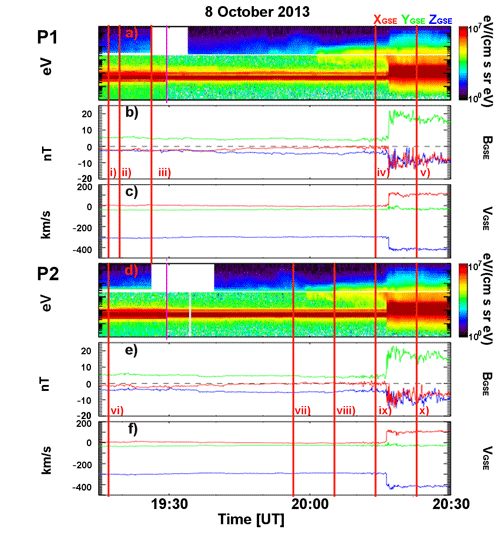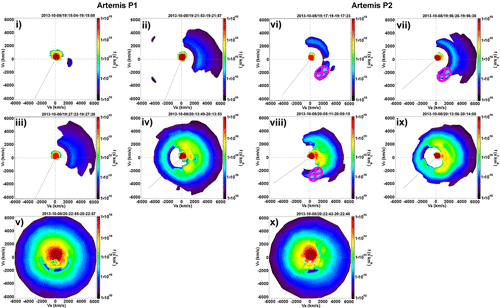2017 ARTEMIS SCIENCE NUGGETS
Ion populations upstream of interplanetary shocks
by Primož Kajdič
Instituto de Geofísica, Universidad Nacional Autónoma de México
Introduction
Interplanetary (IP) shocks are important accelerators of particles in the Solar System. Most of IP shocks form when high speed Interplanetary Coronal Mass Ejections (ICME) travel through interplanetary space or when streams of Solar Wind (SW) with different velocities interact resulting in formation of Stream Interaction Regions (SIR) which are often bounded by IP shocks. Most of the IP shocks detected at heliocentric distances of 1 AU have Alfénic Mach numbers (MA) up to 4 (Blanco-Cano et al. 2017), although shocks with higher MA and magnetosonic (Mms) Mach numbers have been observed (see for example CfA Interplanetary Shock Database at https://www.cfa.harvard.edu/shocks/).
When the shock Mach number is high enough the shocks dissipate the kinetic energy of upstream SW particles by energizing and reflecting a small portion of these (up to 10%) back upstream. It is thought that higher Mach number shocks do this more efficiently. When the angle between the upstream interplanetary magnetic field (IMF), θBn, is less than 45° the shocks are called quasi-parallel and in these cases the reflected particles may escape far upstream from the shocks, forming the so-called ion foreshock. As these ions interact with the incoming SW ions, they excite instabilities, which lead to the formation of the ultra-low frequency (ULF) waves and hence to the ULF wave foreshock.
Studies of particle distribution functions (PDF) of reflected ions upstream of IP shocks showed that they almost always exhibit diffuse distributions. Only Viñas et al. (1984) and Tokar et al. (2000) observed distributions other than diffuse. However, none of these authors could provide details of the ion PDF.
Recently however, we presented the first observations of different types of suprathermal ion distributions upstream of a single IP shock that was observed on 8 October 2013, by ACE and the ARTEMIS P1 and P2 spacecraft. We obtained 3D ion distributions covering the key suprathermal energy range. The P1 and P2 spacecraft first observed field-aligned and gyrating ions arriving from the IP shock. As the shock approached, the ion distributions changed to intermediate and then to almost diffuse. These observations confirm that the same ion acceleration mechanisms that are at work at Earth’s bow-shock also act at IP shocks. However, in the case of the latter the ions can be accelerated to higher energies compared to those at Earth’s bow-shock.
Observations
ARTEMIS P1 and P2 spacecraft observed the IP shock on October 8 2013 at 20:16:56 UT and 20:16:24 UT, respectively. At that time, the P1 and P2 spacecraft separations from the Moon were 10.2 and 2.6 lunar radii (RL) along the Sun-Moon line and 2.0 RL and 10.7 RL perpendicular to it. According to Harada et al. (2015) these distances are large enough so that no significant Moon-related ion fluxes Ion populations at an IP shock should be detected by either of the ARTEMIS spacecraft. Also, the IMF orientation indicates that the spacecraft were not magnetically connected to the Moon nor to the Earth’s bow-shock.
| Figure 1. ARTEMIS P1 and P2 observations. a) and d): dynamic ion spectra from SST and ESA. b) and e): interplanetary magnetic field components. c) and f): SW velocity components. The red, green and blue curves on IMF and velocity panels represent the XGSE, YGSE and ZGSE components, respectively. Roman numbers and vertical red lines mark the times of ion distributions shown in Figure 2. Vertical purple lines mark the times when the ion instruments switched the operational modes. |
The spacecraft obtained the ion PSD at times marked in Figure 1 with red vertical lines. The distributions are shown in in Figure 2. The P1 spacecraft first detected the field-aligned ion beams (FAB, see Figure 2i) with energies of ~21 keV in the spacecraft frame. For comparison, in the case of the Earth’s bow-shock, the FABs exhibit energies less than 10 keV. At 19:21:55 UT (panel 3ii) the ion distribution broadened with maximum energies of 190 keV. Just before the shock (panel 2iv) the ion PDF becomes diffuse. The downstream PDF (panel v) shows heated and isotropic ions.
P2 spacecraft first detected non-gyrotropic PDF (Figure 2vi), which became intermediate (panels vii and viii) and almost completely diffuse just before the shock (panel ix). Downstream of the shock (panel x) the ions are heated and isotropic.
| Figure 2. Ion distribution functions measured by ARTEMIS P1 (i-v) and P2 (vi-x) spacecraft at five different times. The distribution slice planes are defined so that they contain the IMF and the SW velocity vectors. The x-axis (VB) points along the IMF and the y-axis (VV ) points along the SW velocity component perpendicular to the IMF. The black lines show the Sun direction. Colors represent the logarithm of the particle phase space density. Crossed purple ellipses in panels vi), vii) and viii) mark the signal due to photons reflected from the lunar surface. |
Conclusion
The two ARTEMIS spacecraft observed different ion populations upstream of a single, October 8 2013 IP shock. The shock was observed as weaker and quasi-perpendicular (MA= 4.9, θBn=61°) at P1, while it was stronger and less quasi-perpendicular (MA= 5.7, θBn = 47°) at P2.
Ion distributions vary from FABs (at P1) and gyrating ions (at P2) upstream of the shock, to intermediate and finally to diffuse distributions just before the shock arrival. The FABs and the gyrating ions are observed in the absence of any ULF fluctuations, while the diffuse ions coincide with partially compressive ULF waves. The energies of the FABs in the shock rest frame are of the order of 20 keV, which is much more than in the case of the Earth’s bow-shock, where they are ≤10 keV. This is probably a consequence of larger curvature radii of IP shocks and longer connection times of IMF lines to the IP shock surface. Under these conditions ions travel larger distances with θBn < 60° meaning that the shock drift and shock surfing mechanisms accelerate them to higher energies.
References
Kajdič, P., H. Hietala, and X. Blanco-Cano, Different Types of Ion Populations Upstream of the 2013 October 8 Interplanetary Shock, The Astrophys. Jour. Let., 849, 2, doi:10.3847/2041-8213/aa94c6.Blanco-Cano, X., P. Kajdič, E. Aguilar-Rodríguez, C. T. Russell, L. K. Jian, and J. G. Luhmann (2016), Interplanetary shocks and foreshocks observed by STEREO during 2007–2010, J. Geophys. Res. Space Physics, 121, 992–1008, doi:10.1002/2015JA021645.
Harada, Y., J. S. Halekas, A. R. Poppe, Y. Tsugawa, S. Kurita, and J. P. McFadden (2015), Statistical characterization of the foremoon particle and wave morphology: ARTEMIS observations. J. Geophys. Res. Space Physics, 120, 4907–4921. doi: 10.1002/2015JA021211.
Tokar, R. L., S. P. Gary, J. T. Gosling, D. J. McComas, R. M. Skoug, C. W. Smith, N. F. Ness, and D. Haggerty (2000), Suprathermal ions and MHD turbulence observed upstream of an interplanetary shock by Advanced Composition Explorer, J. Geophys. Res., 105(A4), 7521–7531, doi:10.1029/1999JA000097.
Viñas, A. F., M. L. Goldstein, and M. H. Acuña (1984), Spectral analysis of magnetohydrodynamic fluctuations near interplanetary shocks, J. Geophys. Res., 89(A6), 3762–3774, doi:10.1029/JA089iA06p03762.
Biographical Note
Primož Kajdič is a tenure track full time scientist at the Geophysics Institute, Universidad Nacional Autónoma de México. His primary interests are collisionless shocks in the Solar System and the corresponding foreshock regions, magnetosheath jets and space weather at Mars.
 Please send comments/suggestions to
Emmanuel Masongsong / emasongsong @ igpp.ucla.edu
Please send comments/suggestions to
Emmanuel Masongsong / emasongsong @ igpp.ucla.edu

